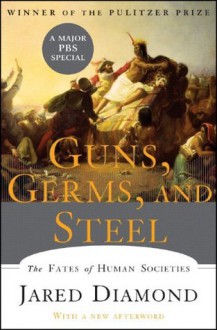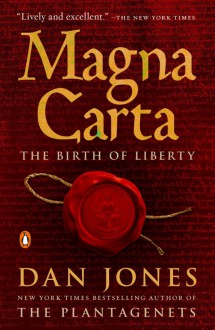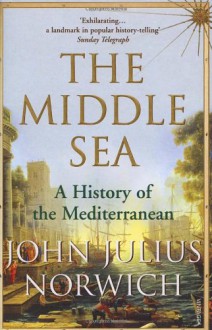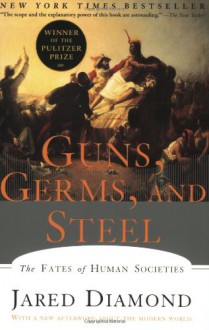
This is an interesting and influential book that in its broad conclusions makes a lot of sense, though I have doubts about Diamond’s reasoning on some of his smaller points. It’s longer than it needs to be, but largely because it is thorough and takes the time to break down academic subjects to be accessible to intelligent but non-specialist readers.
First published in 1997, this book sets out to explain why Europe was able to colonize such a large part of the world in the last few centuries. Europeans’ possession of “guns, germs and steel” was an immediate cause, but why did they have these things when people on many other continents did not? Diamond’s answer comes down to the environment in different parts of the world. In essence, all of these advantages come down to agriculture. In a hunter-gatherer society, population is kept relatively small, people have to focus on acquiring food, and (unless they live in an especially bountiful area), small groups typically need to move from place to place, such that they can’t have too many belongings, especially if they have no domestic animals to carry them. A society built on farming, however, tends to be much more populous, can support a class of people who do something other than farm (an elite class of nobles, but also specialized trades), and can accumulate belongings, which makes developing new technology more worthwhile. So, parts of the world that had a head start on farming also had a head start on developing technology, such as metallurgy.
Meanwhile, European germs played probably the most decisive role in their conquest of the Americas, as well as some other parts of the world; given the size of the native population (an early European visitor to the east coast of the modern U.S. wrote that there didn’t really seem to be room for colonies because the area was so heavily populated) and the difficulty of getting even small numbers of people across the ocean on wooden ships, one can imagine that this could have turned out much more like the English conquest of India, or might not have happened at all, if not for the epidemics that killed some 90% of the population. Why were the Europeans the ones with the germs? Well, human epidemics have come from domestic animals (think swine flu and avian flu today), and epidemics need a large population to stay alive; otherwise they will simply kill everyone they can kill and then die out with no new hosts. Therefore, epidemics evolved in places where people lived in close quarters with domestic animals, and stuck around in populations large enough to produce a new crop of children before the epidemic died out (this is why diseases like measles were once considered “childhood diseases” – not because children were more susceptible, but because the diseases were so prevalent that children would almost inevitably catch them before growing up). Both individuals and populations exposed to these germs would eventually develop immunity if they survived.
But the opportunity to domesticate animals wasn’t spread evenly around the world. Asia and Europe (referred to throughout the book as “Eurasia” since it’s really one landmass, considered two continents for political rather than geographic reasons) had lots of options, including horses, cows, water buffalo, sheep, pigs, and goats. As far as domesticable large mammals go, the Americas had only the llama (which didn’t spread beyond the Andes), while sub-Saharan Africa had none. It isn’t that people didn’t try – people will keep almost anything as a pet – but numerous factors influence whether a large mammal is a good candidate for domestication. It needs to live in herds, to tolerate its own herd’s territory overlapping with others (or you’d never be able to bring in a new cow that wasn’t related to your current cows), to not be overly or unpredictably aggressive toward humans (this is why the zebra has never worked out), to not panic, bolt and throw itself against the fence until it dies, and more. Eurasia had a couple of major advantages here. Being the largest landmass, it had the most animal diversity. And, as modern humans evolved in Africa and Eurasia, animals evolved alongside them, presumably learning how to deal with human hunters’ increasing skills; on the other hand, most large mammals went extinct in the Americas and Australia shortly after people arrived.
With agriculture, too, Eurasia had an advantage, causing it to kick off there early. Again, there was a greater diversity of plants, only some of which make sense to domesticate and begin to grow. The Fertile Crescent (roughly modern-day Iraq and Turkey), perhaps the first site of agriculture in the world, had it particularly easy: wheat already existed in a form quite similar to its modern equivalent, and grew bountifully, so the idea of taking it home and growing it wasn’t much of a leap. On the other hand, with corn – a staple crop of Mexico and eventually the eastern U.S. – there isn’t even agreement on what the wild ancestor was; the plant that might have been the original corn produced husks only about an inch long with tiny kernels and other disadvantages. People had to work on it for a really long time before it became a suitable staple crop for large swathes of the continent.
And then too, you wouldn’t switch from hunting and gathering to farming for just one crop. While hunting and gathering seems like a precarious lifestyle to us, it can actually be better than subsistence farming. Farmers worked harder – which makes sense, since they had to nurture their food every step of the way rather than simply finding it and bringing it home – and based on their skeletons, early farmers’ nutrition was worse than that of hunter-gatherers. So it’s the total package that counts; in areas that provided a nutritionally-balanced diet of domesticable plants, plus domesticable animals to supplement that diet and also provide labor and fertilizer, farming made a lot more sense than it did in areas without such a bounty. Essentially, the sort of lifestyle people had depended on the food options available, and some places supported agriculture much more than others. Nobody’s building a densely-populated empire from a desert like the Australian outback.
There is a lot more to the book of course, but I think it’s the central thesis that’s the most convincing. Many of Diamond’s other points – ancillary to his main argument – don’t work so well. For instance, he’s very interested in how a Spanish force of about 150 managed to defeat and capture the Inca emperor Atahualpa, who was supported by thousands of troops. Certainly the Spanish weaponry played a decisive role, particularly since it was the first time the Inca had encountered guns or cavalry. But Diamond claims that we know well what happened based on the (likely self-serving) accounts of several Spaniards, without apparently realizing that the Inca would probably have told a different story, and then makes a big deal of the fact the Inca lacked writing, arguing this is why they weren’t aware of prior Spanish conquests in Central America and therefore walked into a trap. But this ignores the fact that people who can’t depend on storing information in written form tend to have far better memorization skills than people who write everything down (Homer was not unusual in being able to recite epic poems from memory), and the fact that “they’re going to try to kill you with terrible weapons” is a simple message that could certainly have been transmitted intact had the Inca had envoys in Central America, all while assuming that Atahualpa didn’t know it was a trap. Without contemporary Inca sources, we have no idea whether perhaps he did know, but being new to the throne of an empire destabilized by epidemics, had to go anyway or risk looking weak to his subjects and promptly being overthrown.
There’s some other questionable reasoning here: that it makes sense that the wheel, while invented in Mexico, wasn’t actually used for transportation because there were no animals capable of pulling carts. (So what? People too can transport far more weight on wheels than they can carry.) That New Guineans are probably smarter than Europeans because their society has a higher homicide rate. (A society with lots of murder and warfare would select for strength, skill with weapons, and ability to maintain strong social ties far more than it would select for abstract, creative, or analytical thinking. Plus, an anthropological study of a New Guinea tribe found that those typically targeted for murder were the elderly, who would have already passed on their genes regardless.) And the 2003 epilogue, attempting to apply principles of societal development to how corporations should organize themselves to best promote innovation – apparently inspired by business leaders writing to Diamond about the book – even if true, has nothing to do with the contents of this already-long book.
Obviously there’s a lot to chew on here, hence the long review. I do think the book is worth reading, though it’s unfortunate that Diamond doesn’t cite sources for individual facts, and only includes generalized “further reading” lists. The book has some repetition that makes it a little longer than it needs to be, but overall I think it does a sound job of explaining some of the broad strokes of human history.

 Log in with Facebook
Log in with Facebook 


















